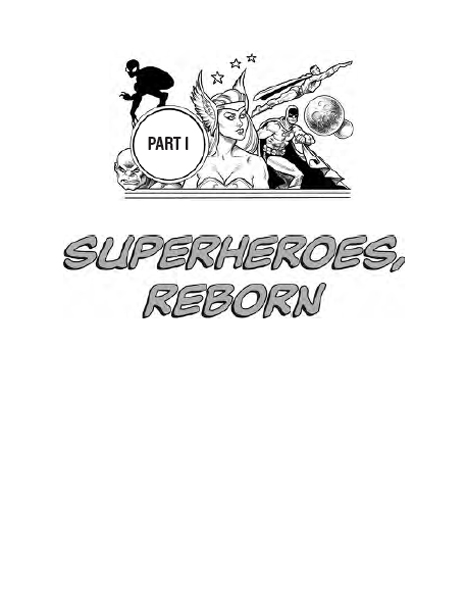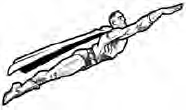Read Our Gods Wear Spandex Online
Authors: Chris Knowles
Our Gods Wear Spandex (2 page)
One of the great American innovations of the twentieth century—besides comic books and superheroes—is the sanctity of childhood. Countless billions are spent making modern childhood a 24/7 Disneyland of indulgence and delight. One could argue that this myth of childhood is the only thing still held sacred in our dehumanized, commercialized society.
Me, I didn't have much of a childhood. Even by 70s standards, it was pretty awful. America's child worship was going through a particularly Calvinist phase in those days of
Rosemary's Baby
and
The Exorcist
, and there were times when my world seemed like a live-action adaptation of
Lord of the Flies
. And almost from the moment of my birth I was in and out of the hospital with chronic pneumonia and bronchitis.
Back then, there wasn't much on TV, no video games to speak of, and the less said about 70s toys the better. What did I have to pass the long hours spent convalescing
alone? Well, I had comic books. Comics then were cheap and disposable. If your mom gave you a quarter for the afternoon you could either buy a can of soda or a comic book. I usually opted for the latter. I actually taught myself to read at the tender age of three, finally getting the hang of it with an old
Superboy
comic. In my first few years of elementary school I read
The Children's Bible, The Children's Dictionary
and the
World Book Encyclopedia
in their entirety. But it was the lowly comic book that really taught me the love of reading.
Another constant in my life was religion. On any given weekend, I could be found attending the Jewish temple where my mother worked as an organist on Friday night, Catholic mass with my friends on Saturday night, and sitting through Methodist marathons with my family on Sundays. But as much as I loved the sacred ambience of these holy places, it was the heroes of the comics and not the Bible where I learned morality and fair play and compassion and decency. It was mythic heroes like The Mighty Thor, Doctor Strange, and Captain America that most inspired me and instilled in me that vital sense of wonder.
I believe that our lives are a rich and complex tapestry, woven together by a web of coincidence. I even believe that trauma can sometimes be beneficial if we use it to our advantage. For instance, a particularly horrible stint in the hospital shortly before I turned five effectively ended my childhood and put me into a perpetual state of hyper-awareness and agitation thereafter. But it was at this time that I saw something in one of my uncle's comic books (
Witching Hour
#12, to be precise) that changed my life forever.
That something was a full-page ad announcing the arrival of comics genius Jack Kirby to DC Comics in 1971. Kirby had created a trinity of titles based on a race of super-beings that he called “The New Gods.” Under a banner screaming “THE MAGIC OF KIRBY!” were the covers of the three new comics:
The New Gods, The Forever People
, and
Mister Miracle
. My five-year-old brain was entranced by the unabashedly religious character of these new heroes. I wouldn't read any of these books until years later, but that one page in that one comic began a lifelong obsession with the man who is largely responsible for dreaming up the gods and demons that made Marvel Comics the powerhouse it is today.
I still proudly remember buying my first Jack Kirby comic book (
Kamandi
#30, “UFO: The Wildest Trip Ever!”), and I am constantly amazed at how many occult,
mythological, and esoteric ideas he introduced to young readers like myself. Today, it seems like these new gods came into my life just when I needed them most.
This book will explain how superheroes have come to fill the role in our modern society that the gods and demigods provided to the ancients. It will catalog the movements and magicians who played a crucial part in the development of social phenomena like the
Batman
or
X-Men
films, or of TV shows like
Heroes
or
Smallville
. But I want to dedicate this book to the man who more than any other believed in our new gods and has inspired generations of other creators and fans to reach beyond the limitations and pitfalls of human existence. If we as a race ever do achieve our apotheosis, it will be in no small part thanks to the vision and inspiration of Mr. Kirby.
This one's for you, Jack.


LOOK, UP IN THE SKY
INVOCATION
Suddenly, superheroes are everywhere. Superman, Batman, and the X-Men rule the box office, with the Spider Man movies alone earning almost $2.5
billion
dollars worldwide. Superhero-themed shows like
Heroes, The 4400, Smallville
, and
Kyle XY
are major cult hits on TV. All across the world, superheroes can be seen on t-shirts, lunch boxes, backpacks, and bedclothes. The superhero industry is very big business indeed, in many ways bigger than ever.
The modern superhero came to life in the midst of the Great Depression and at the dawn of the Second World War. Americans were afraid, and superheroes provided a means of comfort and escape. Superman, the first of the great superheroes, didn't fight robots or space aliens in his early adventures; he fought the
villains that people were really worried about at the time: gangsters, corrupt politicians, fascists, and war profiteers. After Pearl Harbor, superheroes became the mascots of the war effort. Comic books enjoyed circulations in the millions during the war, and were essential reading material for G.I.s overseas.
The story is as old as time; we only call on our gods when we need them. When life is easy, we ignore them. The prophetic books of the Bible are full of wild-eyed visionaries wandering in from the desert and shouting down the people for neglecting Jehovah when the granaries were full. Likewise, we can chart the fortunes of comic-book heroes in American culture by the rise and fall of public confidence and sense of well-being.
The comics boom brought on by Batmania in the late 1980s, for instance, reflected a feeling of genuine terror in urban America fueled by the crack epidemic and the explosion of gang violence that accompanied it. Comic-book creators responded to headlines in the
New York Post
and other crime-driven tabloids and set their four-color vigilantes to work against drug gangs, smugglers, and assorted other street thugs. In the happy-go-lucky Clinton years, however, the popularity of superheroes dropped to its lowest ebb. That would all change on September 11, 2001.
There was a brief moment in time after the World Trade Center towers came crashing down when the world seemed as clear and unambiguous as a superhero comic. Once again, there were good guys and bad guys, villains and victims. The events of 9/11 tapped into a deep-seated need for something or someone to save the civilized world from a faceless, nameless evil that had the power to wreak instant havoc—a kind of destruction previously seen only in comic books or comic-book inspired movies. To fight these invisible demons, we needed
gods
. And indeed, once again, the comic-book industry rebounded—supplying a confused and terror-driven nation with superheroes who would put things to right.
But just two years before 9/11, the superhero industry was on its knees. Thousands of comic-book specialty stores evaporated in a slow but inexorable decline that began in 1994, caused by rampant profiteering and a glut of the most poorly written and drawn comics in the history of the medium. Shell-shocked
fans now refer to those dark times as the “Chromium Age”—a time when tacky gimmicks like covers printed on chromium plastic enticed hobbyists to buy multiple copies of unreadable comics in hopes that their resale value would triple or quadruple. Some fans actually believed that they would get rich on “hot” books, even though tens of thousands of other speculators had also bought dozens of copies. It was a shameless pyramid scheme, one in which only publishers and retailers profited. In the end, it only discredited the medium and hastened the industry's decline. The rise of hi-res video games, home video, and the Internet also threatened the future of the poor, humble comic book.

Comics had been to the brink before, when plummeting sales had threatened the future of the industry in the 1970s. They were saved by the introduction of the “direct market” system, a distribution model in which publishers were guaranteed sales from specialty retailers who bought the books outright, rather than on consignment. In return, the retailers kept the books they didn't sell as back issues and were offered a greater discount for their trouble.
Freed from the crushing financial weight of unsold product and the restrictions of the censorious Comics Code Authority (see
chapter 15
), creators began to experiment with more mature and challenging storylines. In fact, many of the themes that attract millions of moviegoers today have their roots in the ground-breaking stories of the 1980s. Sales began to climb as the content became more sophisticated. These mature works drew in new fans while retaining the interest of older readers who, in the past, usually abandoned comics as they left their teens. Publishers retained the services of talented artists and writers, who might otherwise have left the field for more lucrative work. And royalty and profit-sharing programs allowed top creators to actually get rich. As a result, the 1980s saw a renaissance in American comics.
All this money, however, became the root cause of comics' near-death experience in the 1990s. Titles like
Batman: The Dark Knight Returns
and
Watchmen
not only earned big sales, but they also attracted the interest of the mainstream media. A new breed of creator arose, motivated almost entirely by the money. Many of them were talented and sincere; many were not. But too many of the talentless quickly learned the art of making a sale. At the same time, publishers abandoned long-held standards intended to prevent comic characters from being overexposed or misrepresented. Combine these trends with the artificially inflated sale of back issues, and the floodgates were open.
By the early 1990s, publishers like Image, Acclaim, and Malibu were pushing a sort of crack-cocaine version of superheroes. The model was created by former Marvel artist Rob Liefeld, who developed a garish vocabulary of visual gimmicks calculated to excite gullible fans. Instead of sleek, idealized athletes with colorful-yet-tasteful outfits, superheroes became a riot of bulging veins and ballooned muscles, absurd punk-influenced costumes, cybernetic limbs, and grotesque automatic weapons. Their faces were invariably frozen in grimacing expressions of hate, and they all seemed bent on death and mayhem for its own sake. Stories became nothing but incomprehensible jumbles of action poses, poorly choreographed fight scenes, and explosions. The trend spread, until even the august heroes of Marvel and DC Comics were being done Liefeld style, and the entire market became saturated with promotional gimmicks—variant covers, chromium covers, diecut covers—whose only purpose was to move product.
The turning point came in 1993 with DC Comics' “Death of Superman” stunt in
Superman
#75, which sold millions and brought thousands of new customers into comic stores. The ill-fated marketing ploy left a sour aftertaste, however. True fans knew DC would never leave their signature character dead, and finally realized they were being ripped off. By the middle of the decade, thousands of retailers found themselves buried under piles of unsold product; many stores simply went under. Yet, publishers simply continued spewing out more of the same garbage.